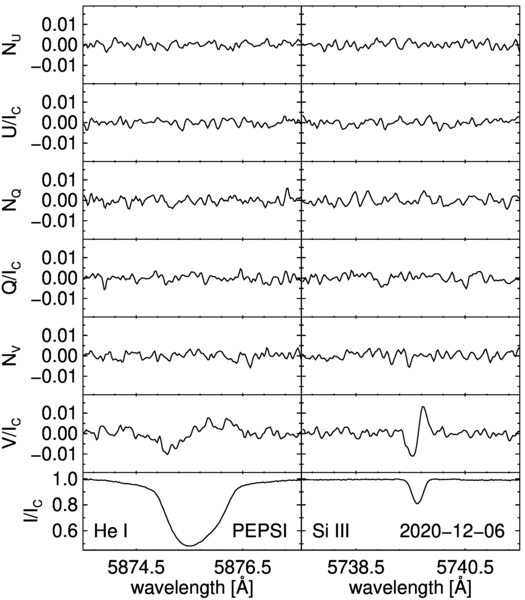The O9.7 V star HD 54879 is currently the only massive magnetic star whose magnetic field geometry and rotation period are not constrained. Over the last three years, we gathered additional observations of this star, obtained using various instruments at several astronomical facilities with, the aim to constrain the rotation period and the magnetic field geometry. The new data include the first full Stokes vector observations with the PEPSI spectropolarimeter, installed at the Large Binocular Telescope. The acquired spectropolarimetric observations show a very slow magnetic field variability related to the extremely slow rotation of HD 54879, which is also indicated in a dynamical spectrum, displaying variability of the Hα line.
Generally, magnetic massive O- and B-type stars exhibit a smooth, single-wave variation of the longitudinal magnetic field during the stellar rotation cycle. The approximately sinusoidal variation of ⟨Bz⟩ and the ratio of the values of the ⟨Bz⟩ extrema in previously studied stars suggest that there is an important component of the field that is dipolar. Assuming that the magnetic field of HD 54879 has a pure dipolar configuration and that the negative field extremum is indeed around −570 G and not at a lower value, we fitted a cosine curve to the observed distribution of data points obtained from the high-resolution spectropolarimetric observations and determined a stellar rotation period of 7.2 yr. Certainly, further monitoring of the magnetic field variability is needed to determine the rotation period with more confidence. We note, that magnetic studies of several O-type stars indicate that only one magnetic pole is well visible while the star rotates, implying that the magnetic field structure over the fraction of their invisible surface remains unconstrained.

Read more: Järvinen et al. 2022, MNRAS, 501, 4405. arXiv
